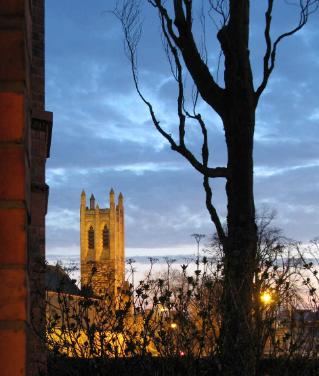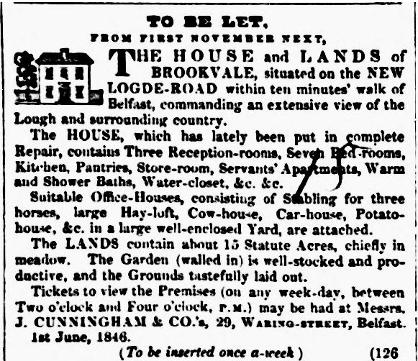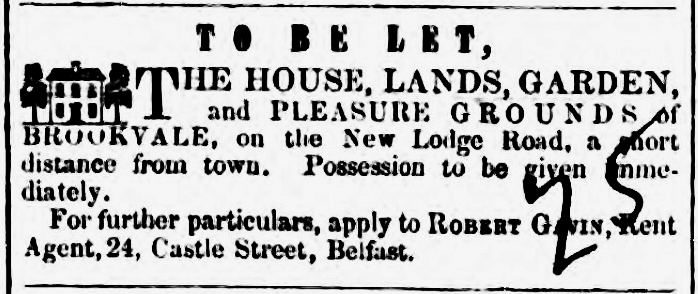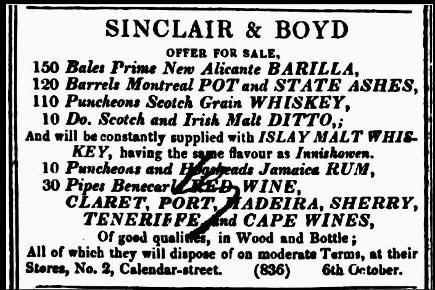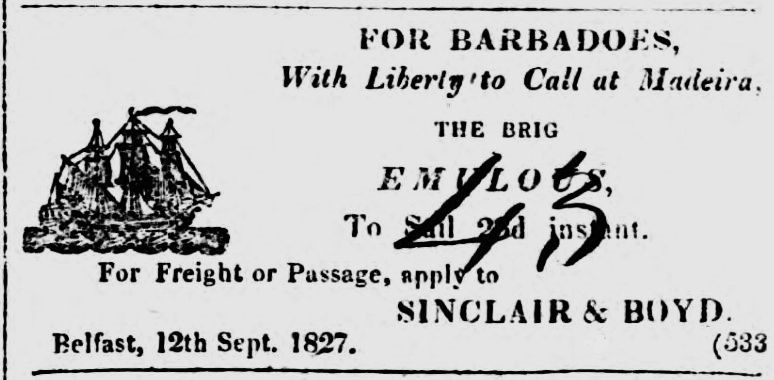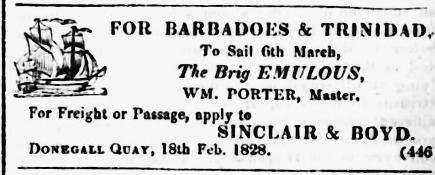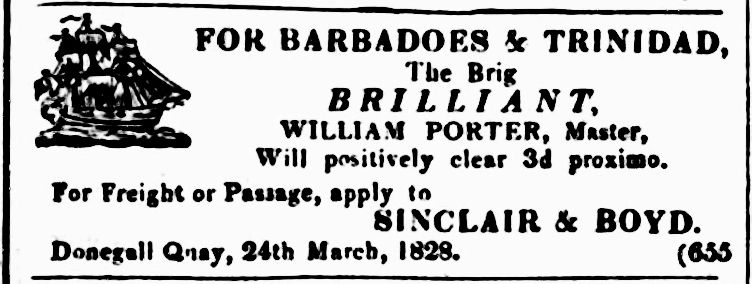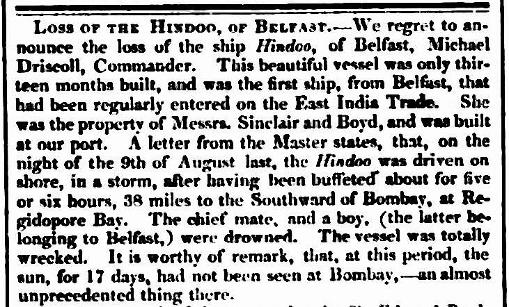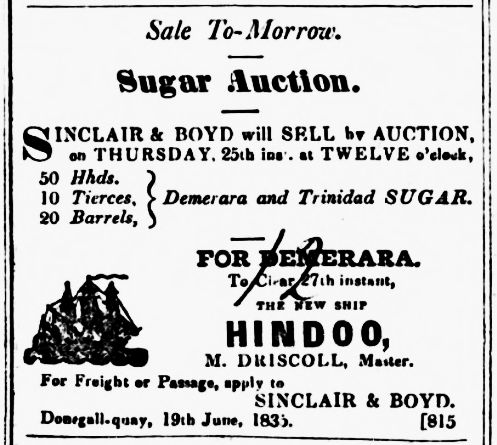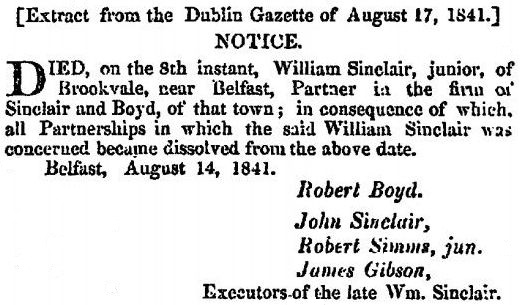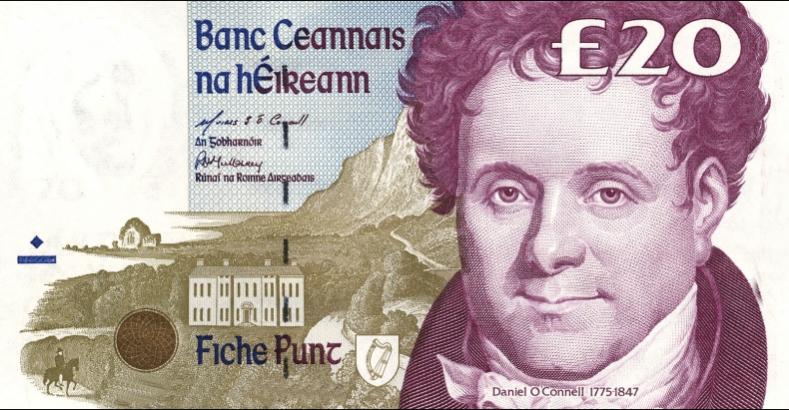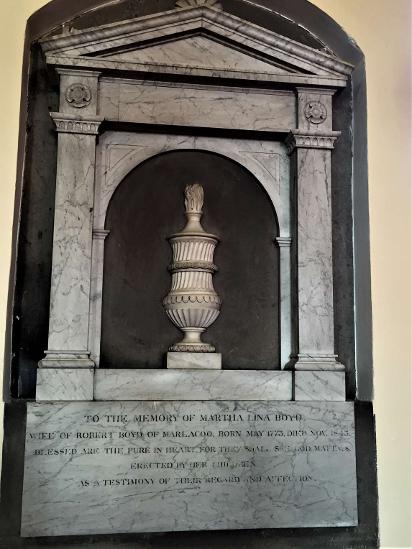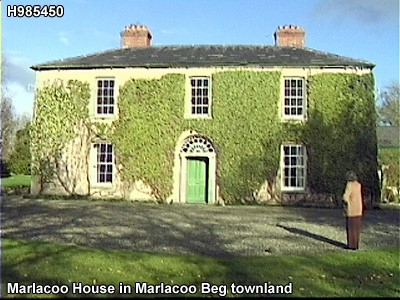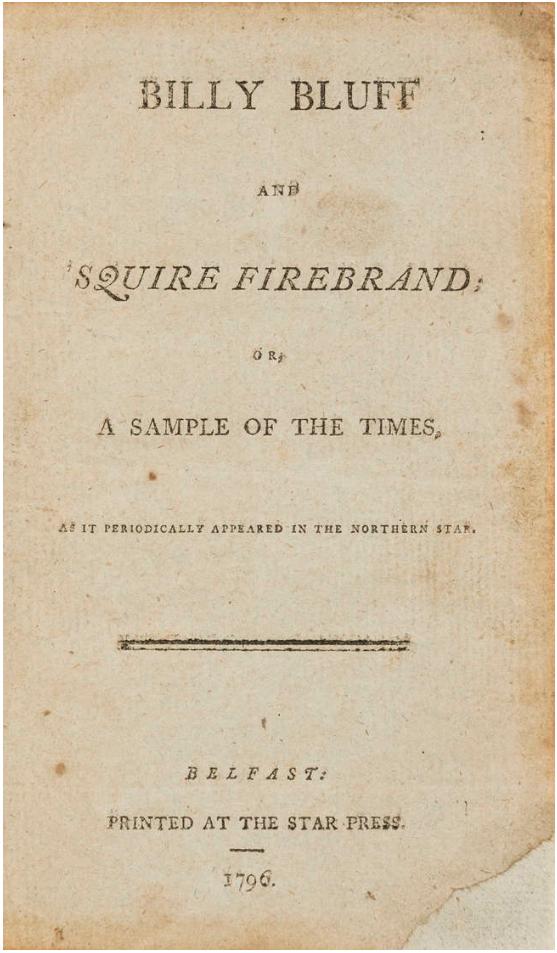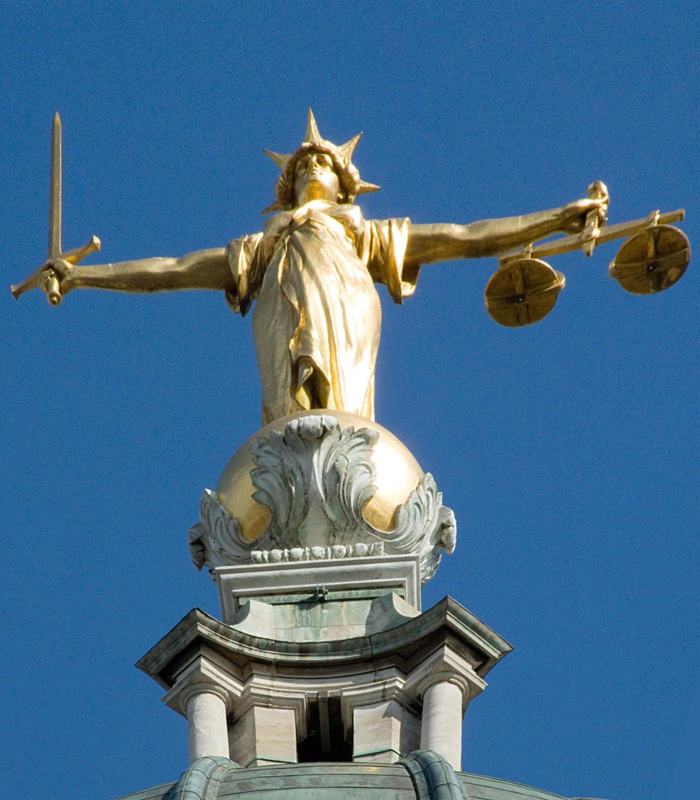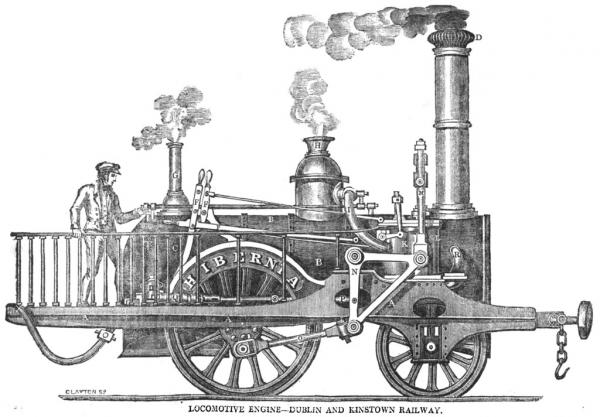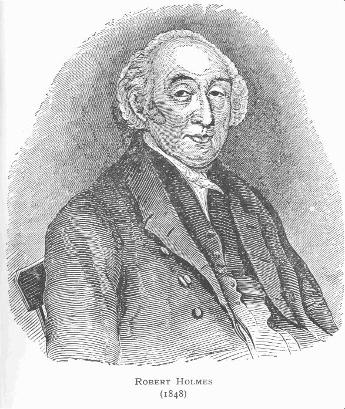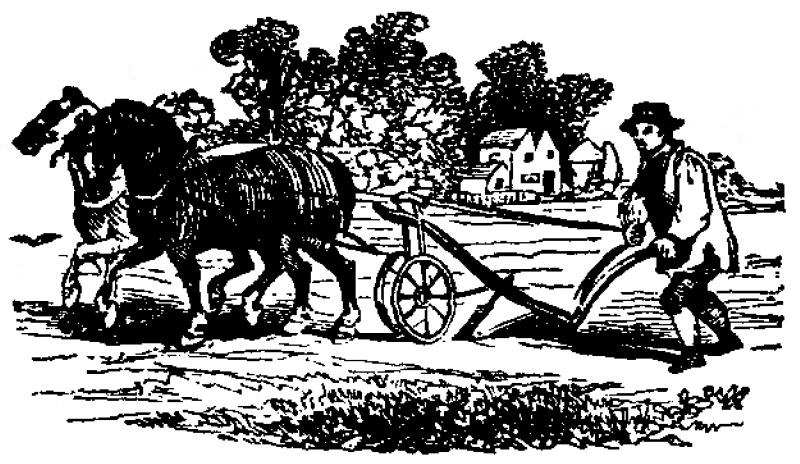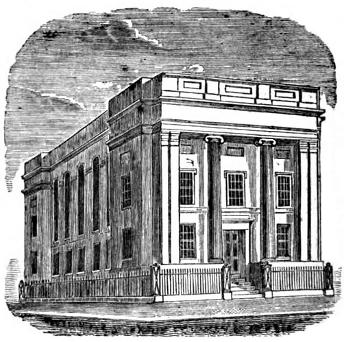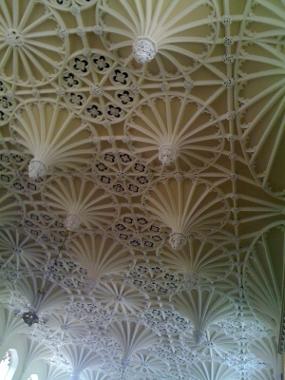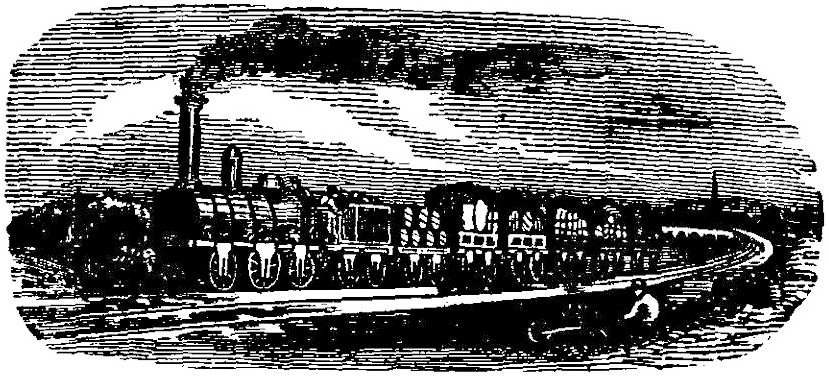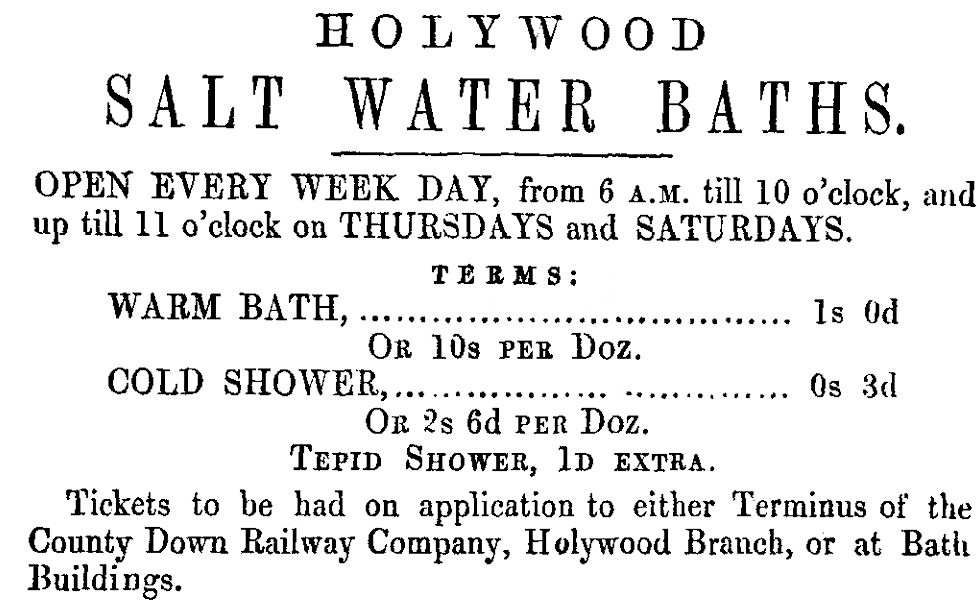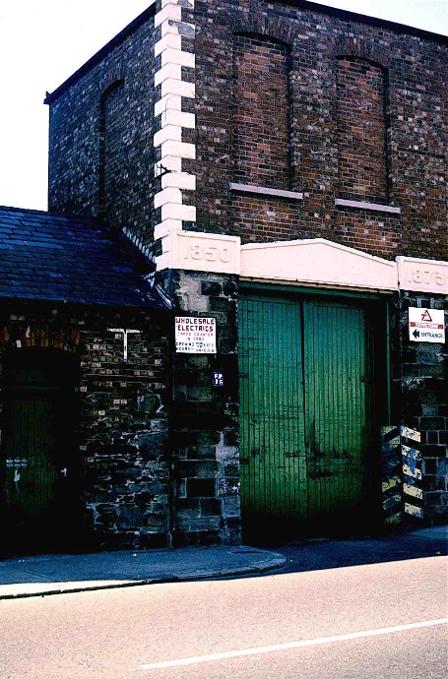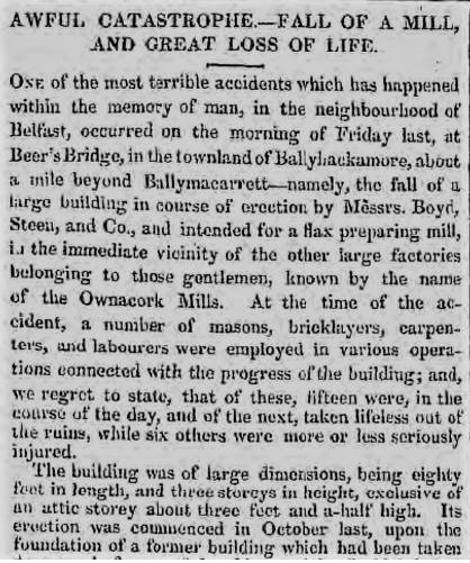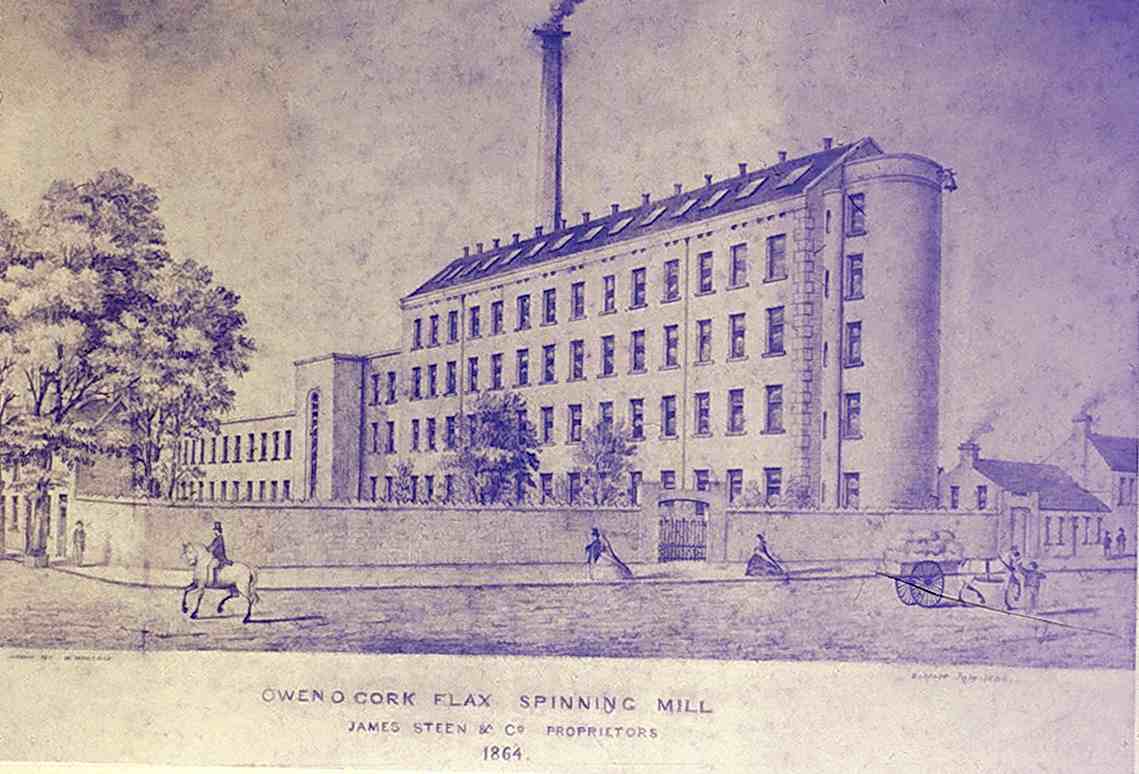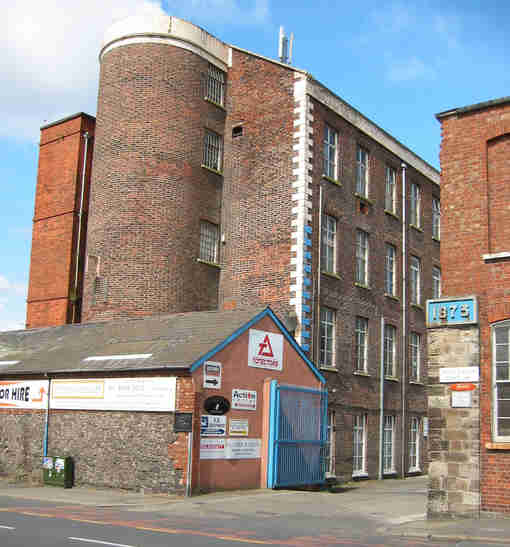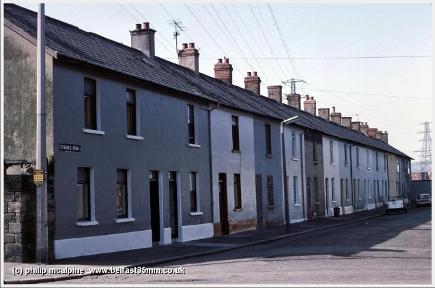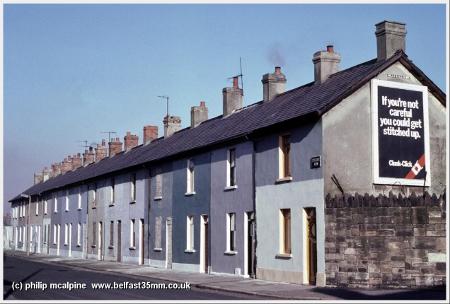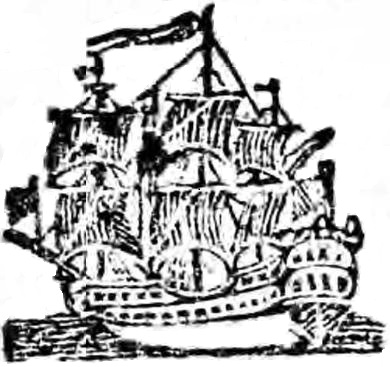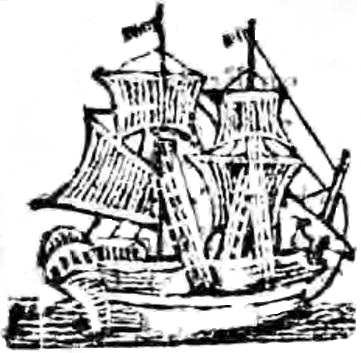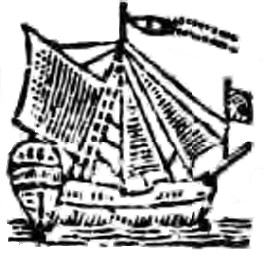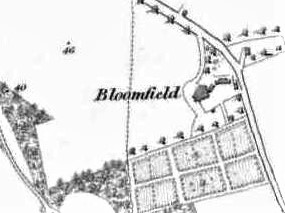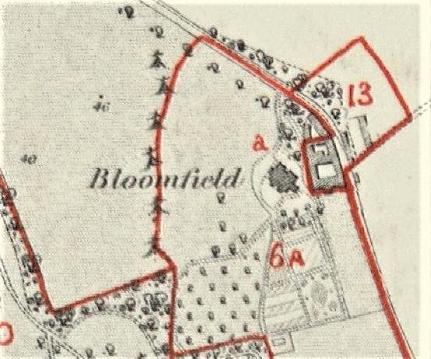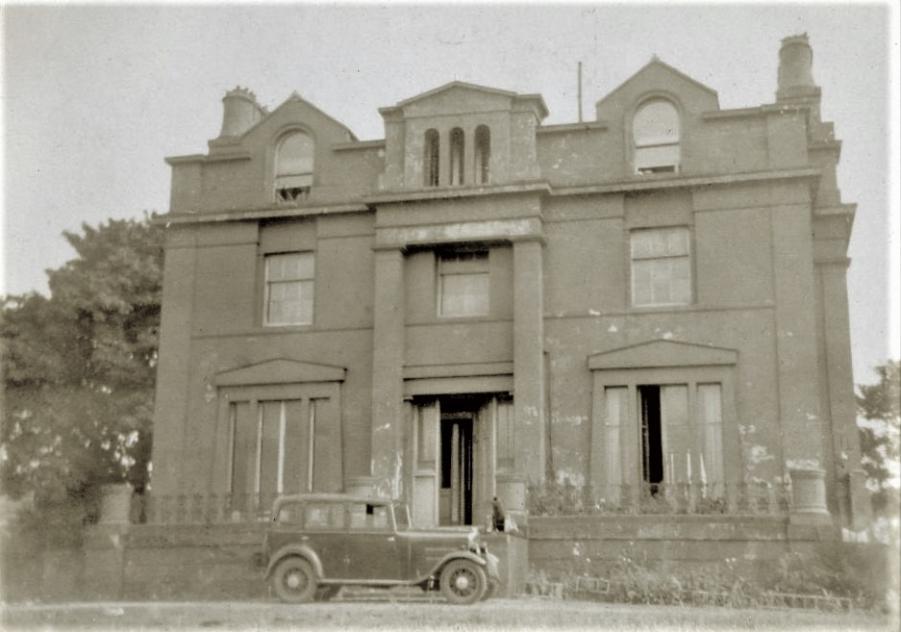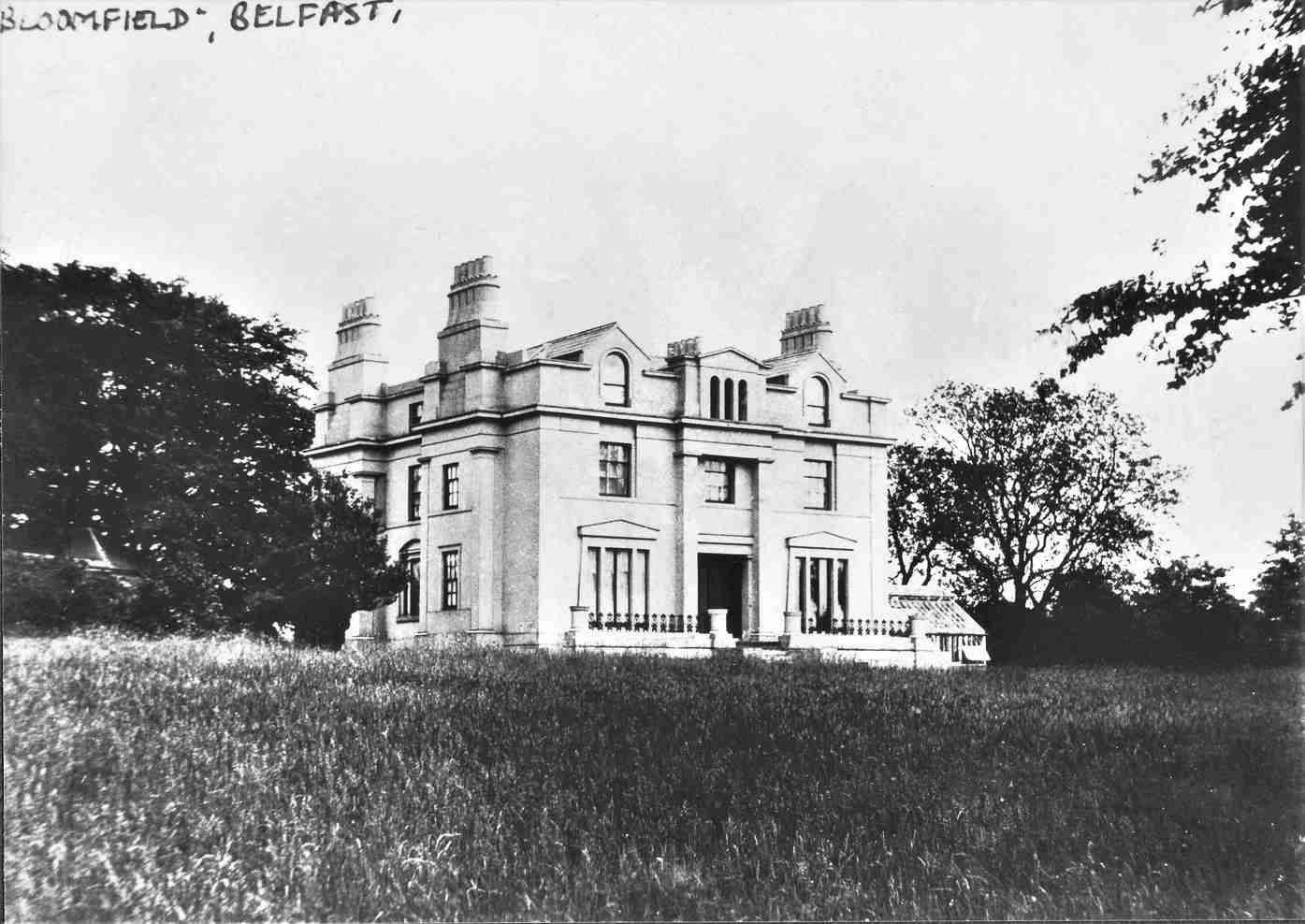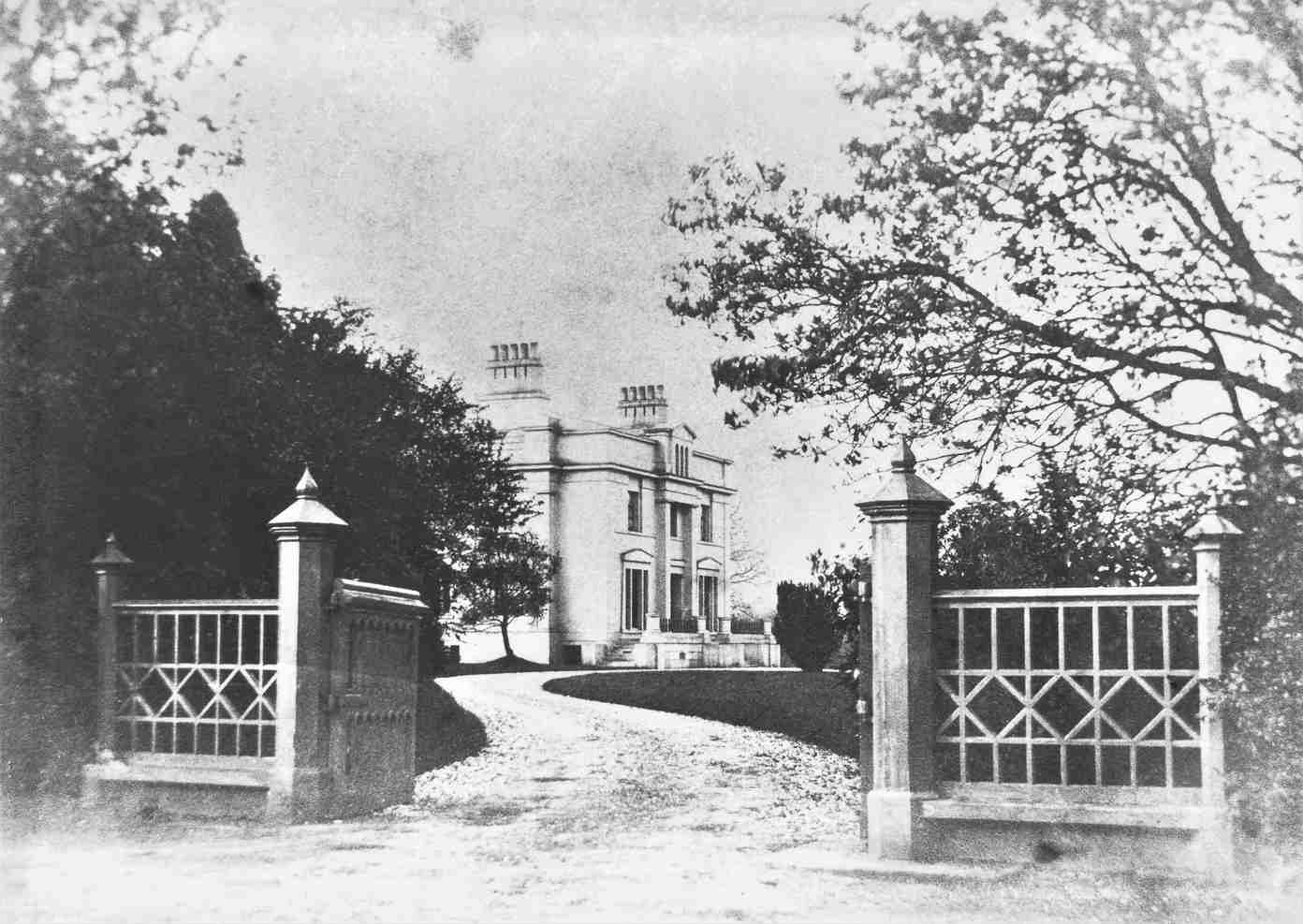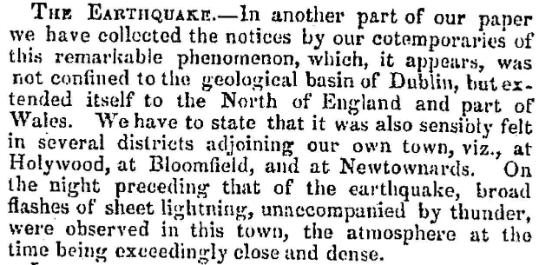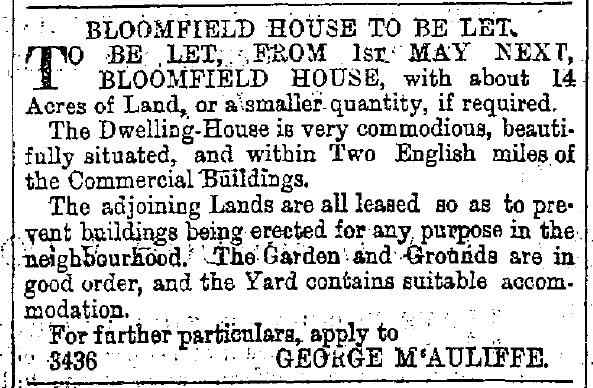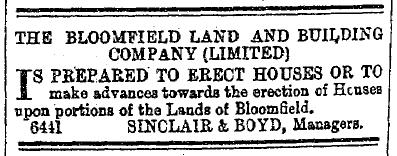This page is very much a work in slow progress.
Bloomfield House advertised for sale
John Agnew advertised his home, Bloomfield House, for sale during his last term in office as Sovereign and Chief Magistrate of Belfast. However, it remains unclear as to when he actually left Bloomfield (perhaps for Donaghadee where he died in August 1844). He may have remained 'in residence' at Bloomfield almost right up to his death.
As noted on the previous webpage (see Agnew 1831-1844), 'New Hay, belonging to John Agnew, Esq., Bloomfield, was sold in our market on Wednesday' (Belfast News-Letter, Friday 16 June 1843, page 4). So John Agnew's farm was still in business on his account. Indeed, the Belfast Street Directory for 1843 has a listing for 'Agnew, John, Esq., Bloomfield'.
The following advertisement, with a rider stating 'To be inserted once a week', had appeared in the Belfast Commercial Chronicle from early September 1840 through to mid-February 1841. Bloomfield House clearly didn't sell at that stage.
The 1831 lease mentioned in the advertisement surely refers to John Agnew's original purchase; but what is the 1838 lease about?
Eligible Residence near Belfast
WITH LAND ATTACHED,
FOR SALE.
_____
TO BE SOLD BY PRIVATE CONTRACT,
THE Mansion-House of BLOOMFIELD, and LANDS connected therewith, containing 79 Acres and 3 Roods, English Statute Measure, held under SAMUEL CLELAND, Esq. by two Leases, for unexpired terms of one, and two young lives and 31 years, one lease commencing from November, 1831, the other from November, 1838.
This most desirable residence is situate in the Parish of HOLYWOOD, adjoining Orangefield, and within one mile and a half of the Town of Belfast. The House is quite new, beautifully situated, and capable of accommodating a large family. The Grounds are extensive, and in the finest order.
For particulars, apply to the Proprietor, at BLOOMFIELD; or to RICHARD DAVISON, Esq. Solicitor, Belfast.
'The House is quite new ...' is a surprise. How does this 'new house' from, say, around 1838, match up to (Spoiler alert!) the 1845 complaint from the next owner, Robert Boyd, that 'The dwelling house and offices were in a very dilapidated state'?
The Sinclairs of 'Sinclair & Boyd'
So the next chapter in the history of Bloomfield House belongs to Robert Boyd (1803-1869) ... BUT ...
Before delving into his family genealogy to find where he came from, it’s necessary to explain that he was the ‘Boyd’ in the important Belfast trading company Sinclair & Boyd, founded c.1822 - so (surprise!) a short digression is necessary.
Belfast had several important Sinclair families. This particular ‘Sinclair’ was William Sinclair jun., of Brookvale (sometimes 'Brookvale Lodge'), New Lodge Road, north Belfast. The house is clearly marked on the map of Belfast made by James Williamson in 1791, though its then resident is named as Mr Warren.
A somewhat abbreviated genealogy for this particular
Sinclair family reveals that a John Sinclair was born in 1740 to William
and Anne (née Officer) Sinclair. John Sinclair (1740-????) married
Mary Harper and they had three children: William (1758-1842), Henry
(1761-1847) and James (1767-1849).
That William (William sen. for our purposes) married Elizabeth Montgomery (c.1764-1834) .
They lived at Brookvale, Belfast. Their surviving children were (or included):
Jane (1801-1878) who married Robert Simms in 1827;
William jun. (c.1804-1841) - more of him below;
John (1808-1856) who married Eliza Pirrie in 1835 -
Sinclair Seamen's Church in Belfast was built in his memory;
Mary (1809-1842) who married Samuel Gibson in 1829;
and Thomas (1810-1867) of Hopefield House who
married (i) Sarah Archer (1800-1849) in 1835 and (ii) Elizabeth Sydney Edgar in 1855.
RH pic: Belfast Commercial Chronicle, Mondays, June 1846. Below: Banner of Ulster, Friday 21 September 1849.
William jun. married Mary Gibson (c.1806-1887), 'only daughter of the late James Gibson, Esq. Belfast', on 03 October 1826 in the First Presbyterian Church, Rosemary Street. (Mary was likely the sister of Samuel Gibson who would marry Mary Sinclair in 1829.)
It
was this William Sinclair who was the business partner with Robert Boyd
in Messrs. Sinclair and Boyd, East and West India merchants.
By several accounts, Sinclair and Boyd was established in 1822, but the first mention I can find in the press was this report on page 2 of the Belfast Commercial Chronicle for Saturday 5 August 1826:
Yesterday, a fine brig, called the Emulous, about 200 tons burthen, built of British and Sierra Leone oak, was launched from the Ship-yard of Messrs. RITCHIE & McLAINE, and went off the stocks in a desirable style, amidst the cheers of a vast concourse of spectators. She was built for our respectable young Townsmen, Messrs. SINCLAIRE [sic] & BOYD, and is intended for the West India Trade.
Thereafter there are many advertisements for Sinclair & Boyd, revealing the breadth of their business. Here are just a select few:
Above: Belfast Commercial Chronicle, Saturday 07 October 1826, page 3
Top right: Belfast Commercial Chronicle, Wednesday 12 September 1827, page 3
Bottom right: Belfast Commercial Chronicle, Wednesday 27 February 1828, page 3 (20 Feb - 08 March)
Page 1 of the Belfast News-Letter, Tuesday 01 January 1828, carried a listing ‘From Cramsie’s Belfast Mercantile Register’ of Belfast Shipping. It was in two sections: (i) Foreign Trade (46 ships) and (ii) Engaged in the British and Coasting Trade (126 ships). The name of each vessel was followed by the Tons Register and the Owners.
Under Foreign Trade, the largest was the Thomas Gelson, 441 tons, owned by ‘John Martin & Co. and others’ (John Martin & Co – presumably without ‘others’ – also owned the Edward Downes, 322 tons, and the Hope, 168 tons); the smallest was the Hopewell of 101 tons owned by Henry Joy Holmes, who also owned the Henry Tate of 258 tons.
Included in the list was the Emulous, 194 tons, of Sinclair & Boyd.
In the second list, Margaret, 67 tons, was owned by J. Holmes and others.
Business began to expand with new ships:
RH pic: Belfast Commercial Chronicle, Monday 31 March 1828, page 3
The firm of Sinclair and Boyd was certainly a prominent one in Belfast trading. It also provided plenty of work for the Belfast shipbuilders, Charles Connell and Sons.
The following report is from page 2 of the Belfast News-Letter, Friday 15 May 1835:
LAUNCH — Yesterday forenoon the Shipyard of Messrs. Chas. Connell and Sons was a scene of great and unusual attraction, in consequence of the intended launch of one of the largest vessels ever built in Ireland. The day having been highly favourable, immense crowds assembled about 11 o’clock, and completely filled every vacant space in the neighbourhood of the quays, from which a sight of the vessel could be possibly obtained. The vessels and boats in the river were also similarly crowded, and the attraction of the scene was heightened by the presence of the excellent Band of the 46th, who attended on board by permission of Colonel Campbell, and performed a number of favourite pieces of music.
At length, after various preparatory signals, at half past 11 the vessel launched in gallant style, and the discharge of numerous pieces of ordnance both on board and on the shore. The ceremony of “christening” was then gone through, and the ship was appropriately named the “HINDOO”. She is intended for the East India and China trade, and is fully 800 tons burthen. The owners, we understand, are Messrs. Sinclaire [sic] and Boyd, Messrs. John and Thos. Sinclaire, and J. Macnamara and Co.
An article by Captain R H Davis in the Belfast Telegraph, 13 June 1941, page 4 also deals at length with the same Belfast shipbuilding firm and mentions several of their ships, along with the loss of Sinclair & Boyd's Hindoo:
... Next in succession was launched the Tickler, Hindoo, Brigand, and Splendid. Of these four vessels the Hindoo was outstanding, and she made a record by being the first full-rigged ship ever built in Ireland. She was built [in 1835] for the China and East Indian trade, and was supposed to be of 800 tons, and was also one of the largest vessels built in Ireland up to that time.
Her owners were Messrs. Sinclair & Boyd, Messrs. John and Thomas Sinclair [brothers of William Sinclair], and J. McNamara [sic]. Her career was a short one. On August 9 in the following year she was lost in a heavy gale in Regedopore Bay, 38 miles south of Bombay, and became a total wreck. It is mentioned that for a period of seventeen days the sun had not been seen at Bombay, an almost unprecedented experience there. (This date would be about the change of the Monsoons).
Capt. Davis's complete 1941 article about Connell's Shipyard is given in the PDF on the right:
The source for that report was clearly the following news story (below, left) from the Northern Whig, Thursday 08 December 1836, page 3. The earlier advertisement (below right) is from page 3 of the Belfast Commercial Chronicle, Wednesday 24 June 1835.
The following paragraphs are from another Belfast Telegraph article by Captain R H Davis, this time from Thursday, 30 April 1942, page 2.
The Emulus [sic] had a long career and was a tribute to her builders.
The Lina was another of the firm’s [Sinclair & Boyd's] ships. She was built by Charles Connell & Sons in 1847. A young girl was killed at her launch by a piece of ordnance that was fired as she came off the stocks. In 1851 this vessel arrived at Belfast from Barbados with a cargo of sugar, having made the round voyage, loaded with a full cargo both ways, in two months and 26 days. They were also the owners of the beautiful little schooner Cree, built by Charles Connell in 1840, and said to be the smallest vessel that ever cleared out of this port for a voyage across the Atlantic.
In 1844 their brig the Morgiana made the record passage of the season from Belfast to Miramichi.
Another of their West India traders was the brig Parrsboro. She sailed the day after the mail steamer and arrived at our quay on June 9, 1843, the same day that the mail steamer arrived at Falmouth. In 16 hours she discharged her full cargo of sugar and inside a week sailed again fully laden for a West India port.
The firm were also owners of the barque Rebecca, built by Alen McLaine [=Alexander MacLaine (1774-1856)] in 1834; the Lady May [=Mary] Fox and the Waringsford. The latter vessel went missing in 1851. In nearly all the vessels I have mentioned, a Mr. James Macnamara, of Holywood, had a financial interest with Mr. Robert Boyd.
Despite the occasional and tragic loss of ships, business for Sinclair & Boyd seems to have flourished, whether selling 50,000 US barrel staves; Pockets of Sussex Hops 'sold cheap'; Puncheons of Scotch Grain Whiskey [sic]; Hogsheads and Barrels of Trinidad Sugar; Butts, Hogsheads and Quarter Casks of Sherry Wine; Pipes, and Hogsheads of Port, Madeira, Teneriffe, Cape, Claret and Port Wines in Bottle, 1,000 Bushels of Grass-Seed ... the list goes on.
The 1840s marked new directions for Robert Boyd, shortly to take up residence in Bloomfield House.
This next one presumably came as a considerable shock:
LH notice from the London Gazette, 24 August 1841.
John was William's younger brother; Robert Simms was the husband of William's sister Jane; James was probably a brother of William's wife.
Things moved quickly in Belfast at that time.
The Northern Whig reported on 12 August that Hugh Magill 'of the respectable house of Messrs. John S. Ferguson & Co., has been proposed as a candidate to fill the situation in the Corporation for the Improvement of the Port and Harbour, caused by the death of Mr. William Sinclair'.
William Sinclair was just 38. His 'younger son', James Gibson Sinclair, had died the previous year (April 1840), aged three; William's father, William Sinclair sen., died the following year (August 1842), aged 84.
A second James, born in 1841, died in November 1842, aged 15 months.
All were buried in Belfast's Clifton Street Cemetery.
For completeness sake, William Sinclair jun., was survived by a son, also called William (c.1827-1881) and a daughter, Sarah (described in her 1851 marriage notice as 'eldest daughter', so there must be another daughter out there!).
Long before the death of business partner William Sinclair, there was another long-standing business associate of Robert Boyd who appears often in news reports. He was James Macnamara of Holywood whose appointment as a magistrate in July 1836 caused a controversy, seemingly stirred up along sectarian lines. It's encouraging to note that Robert Boyd, a member of Belfast's First Presbyterian Church, Rosemary-street, was a liberal thinker who supported Catholic emancipation. As indeed were the Steen family, the Sinclairs and William Radcliff of the Beer's-bridge Mill (Owen O'Cork), amongst many others.
The following PDF tells of the controversy, lists the Belfast townspeople who signed the supportive petition and also reports on the 'Great [Daniel] O'Connell Demonstration in Belfast' held in the theatre in June 1844 and features both Robert Boyd and James Macnamara.
RH pic: The pre-Euro £20 Irish bank-note featuring Daniel O'Connell, 'The Emancipator'.
The Boyd family tree and Marlacoo House, Tandragee
Robert Boyd continued to run the business, retaining the name Sinclair & Boyd. But where was he from?
The PDF document, below right, is an attempt at a family tree for this particular Boyd family. I'm indebted to Lawrence H Boyd for his initial draft which was originally available online but has long since disappeared.
The earliest Boyd we have is our Robert Boyd's grandfather and grandmother, the 18th century James Boyd, born 1726, and his wife, Susannah Browne - both said to be from Coleraine. In 1795, their eldest son, Robert Boyd (1772-1846), married Martha Lina Turkington (1773-1843) and they settled at Marlacoo Beg, between Richill and Tandragee in Co Armagh (though perhaps by then, Marlacoo Beg was already the home of Robert's father, James).
The family seems to have been comfortably 'well off', building (or maybe rebuilding) a dwelling house in 1815.
Marlacoo House, a fine two storey, three bay, Georgian building, still stands in the townland of Marlacoo Beg in the parish of Mullaghbrack, Co Armagh, beside Marlacoo Lake. Do check out the photographs and a spoken introduction to the house here. The children of Robert and Martha Boyd erected a fine memorial to their mother in nearby Mullaghbrack Church.
It reads: To the memory of Martha Lina Boyd, wife of Robert Boyd of Marlacoo, born May 1773, died Nov. 1843.
Blessed are the pure in heart, for they shall see God. Matt.5.8.
Erected by her children
as a testimony of their regard and affection.
LH pic: The Boyd Memorial in St John's Parish Church, Mullaghbrack (or Mullabrack), photograph courtesy of Primrose Wilson.
The 1838 Ordnance Survey Memoirs mention two flax mills in the townland, both the property of Robert Boyd: one is described as having a wheel '10 feet in diameter and 3 feet in breadth. It is a breast wheel and machinery of wood, built 1837'. The other has a wheel '16 feet in diameter and 3 feet in breadth, the machinery [also] of wood'.
RH pic: Marlacoo House, 1815. For the use of this photo I am grateful to Primrose Wilson and the Bygones and Byways local-history website about Markethill and District in mid-Armagh.
Do check out more photographs and a spoken introduction to the house here on the Bygones and Byways website.
As already noted, Martha Boyd died in 1843. Her husband, Robert Boyd sen., died in 1846. It was the end of an era.
The house and lands were advertised for sale across August to November 1846. It wasn't a quick sale. The contents were advertised in May 1848 as an unreserved sale by auction on the first and second of June: 'the entire Household Furniture, &c., &c., &c., of Marlacoo House, the Residence of the late ROBERT BOYD, Esq.' The headline mentioned a piano, gig, car, farming implements, &c.
The following advertisement, with occasional variances, appeared frequently in the Northern Whig and the Newry Telegraph between August and November, 1846:
TO BE SOLD,
THE TOWN AND LANDS OF MARLACOO-BEG, with its sub-denominations, situate in the Parish of MULLABRACK, Barony of O’Neiland, and County of Armagh, containing 208 Acres, Statute measure, or thereabouts, including about 11 Acres under water, held in fee, and subject to neither Quit nor Crown Rent.
The Lands are adjacent to the public road from Armagh to Tandragee, which runs past the entrance gate leading to the Mansion-house, a little more than 5 miles from the former and not 3 from the latter town, about 11 miles from Newry, 8 from Lurgan, 4 from Portadown, 2 from Markethill, and in a most respectable, quiet neighbourhood. They are all of prime quality, well sheltered and watered; upwards of 140 Acres of them are held by a respectable, industrious, and solvent tenantry, at fair rents, producing £206 per annum, as will appear by the published Rentals. The remaining portion was held by ROBERT BOYD Esq., deceased, the late Proprietor, in his own hands, and is in the best possible condition. There are Five Acres of this portion occupied by Ornamental and other Planting; and the late Mr. BOYD, on it, built a Capital and Comfortable RESIDENCE, for the Family of a Gentleman, with suitable OFFICES, GARDENS, &c., situate in an extensive Lawn, terminated by a Lake, of great extent and considerable beauty. The House and Offices are in good order, and fit for the immediate reception of a Respectable Family. There are Two Falls, of Sixteen Feet each, on the Lands, at present used by the Mills for the Dressing of Flax.
This property is advertised by Messrs. WILLIAM STEEN and ROBERT BOYD, of Belfast, and by Mr. JAMES BROWN BOYD, of Balleer, Armagh, Trustees and Executors of the late Proprietor, under the trusts of his will; and they, or Mr WILLIAM PEEBLES, North Frederick-Street, Dublin, or Dungannon, their Law Agent, will afford every information to a purchaser, who, by application to Mr. PEEBLES, can see the abstract of Title and Title Deeds, and also the Map, Rental, &c., of the Estate.
Rentals are in course of publication, and will shortly be ready for delivery.
The Lands will be Sold by PUBLIC AUCTION …
Dated this 29th day of October, 1846
The sale was unsuccessful. In 1848, the house, garden and orchard, &c., (what a multiplicity of things is contained in these ampersand etceteras!) were being advertised ‘To be let’ (e.g. Northern Whig, Saturday, 1 April 1848, page 3). I recall reading somewhere, and I haven’t managed as yet to retrace my steps, that the house was finally sold in 1856 (perhaps sold as part of the Encumbered Estates’ Court. PRONI has 'An Incumbered Estates Court rental of the lands of Marlacoobeg Co. Armagh, the property of Robert Boyd, deceased; 1856' - ref. D958 ).
Bloomfield landlords - The Cleland family of Storm Mount
The 1839 Belfast Street Directory has Sinclair & Boyd, ship owner and general merchant, at 45 Donegall Quay and Robert Boyd himself living at 7 Great George's Street - a house which must have been almost 'above the shop'.
Having grown up in Marlacoo House, and with a business partner, William Sinclair, 'of Brookvale', it's no wonder that Robert Boyd aspired to his own mansion house.
His appetite was surely whetted by the 1840/41 newspaper advertisements for a 'most desirable residence', viz. the Mansion-House of Bloomfield and its 79 acres of land, with its landlord Samuel Cleland.
The Cleland family certainly merits another short digression. And it begins with Samuel’s father, Rev John Cleland (1755-1834), who tutored young Robert Stewart (eventually Lord Castlereagh) from the age of ten at Mount Stewart, home of Robert’s father, also Robert, who became Lord Londonderry.
Cleland, the Rector of Newtownards (1789-1809), was a family friend of the Londonderrys and also Lord Londonderry’s land agent. 1796 was an eventful one for Cleland. He was appointed Chancellor of Lismore; his friends and employers were lampooned in the clever satire Billy Bluff and Squire Firebrand published in the Northern Star that year; and an unsuccessful attempt was made on his life.
‘Black John’ was certainly no friend to the United Irishmen.
For the record, the Northern Star’s satire consisted of seven anonymous letters attributed to 'A Presbyterian'.
‘Billy Bluff’ was William Lowry, bailiff on the Greyabbey estate;
‘Lord Mountmumble’ was Robert Stewart, later Lord Londonderry; ‘Squire Firebrand’ was Hugh Montgomery of Rosemount, Greyabbey, and not, as some have thought, John Cleland.
In 1797 Cleland was accused of packing juries against suspected United Irishmen and of passing on information to the authorities about known United Irishmen. As Judge Advocate he oversaw many trials which resulted in sentences of death, transportation or flogging. It was he who sentenced the Rev James Porter, the dissenting minister of Greyabbey, to death in 1798. Porter had been in favour of parliamentary reform and catholic emancipation and he was the author of Billy Bluff. Porter was hung atop a hill in full view of his meeting house and his home on 2 July 1798. He was just 45.
LH pic: a copy of Billy Bluff sold by Forum Auctions, London, 27 September 2017.
Cleland was further disliked for his harsh treatment of
tenants when he was collecting rents, profiting all the time for
himself. In 1802 he was appointed Precentor of Armagh (which came with being the Rector of Killeavy), an appointment like that of Chancellor of Lismore which he retained for life. The role was ‘presented by the Crown’, presumably as a reward for his role in helping defeat the United Irishmen. The Belfast News-Letter reported that the Rev John Cleland was claiming tithes on the marshes of Newry (BNL, 16 August 1808).
This was the man who, much to his advantage, in 1805 married Esther Jackson (1785-?) of Storm Mount (aka Mount Pleasant, Ballymiscaw, Dundonald). Cleland moved from Newtownards to Storm Mount. In 1830 he built there ‘a large plain house with very little planting about it’. He also acquired more land in the area (Ballymiscaw, Killeen and Ballyhackamore which included Bloomfield), and Rose Park, the more substantial neighbouring house to Storm Mount. The couple had two sons and a daughter.
When Rev John died on 25 June 1834, he was succeeded by his eldest son Samuel Jackson Cleland - the 'Samuel' mentioned in the lease of Bloomfield House.
That same year, Samuel, b.1808, married Eliza Joyce of Thornhill and they had four sons and a daughter.
Alas, while Samuel was helping to demolish part of Rose Park in 1843, he died when a wall fell on him.
This report is from the Warder and Dublin Weekly Mail - Saturday 28 May 1842, page 7:
An accident, which has proved fatal in its results, occurred on Friday, about two o’clock, to Samuel Cleland, Esq., at his residence, Stormount, within a short distance of Belfast. It appears he had employed a number of men in pulling down an old house, lately occupied by one of his own servants. While the men were proceeding with the work, as Mr. Cleland was superintending their operations, the gable of the house suddenly gave way, and coming down with a tremendous crash, buried the unfortunate gentleman beneath its ruins. He expired almost instantaneously. Deceased was a magistrate of the counties of Down and Antrim. One of the labourers was also seriously injured by the falling of the house, so that he lies in a very dangerous state, his life being despaired of.
— Ulster Times.
Samuel’s eldest son, John (1836-1893), would oversee the transformation of his
grandfather’s ‘plain house’ into ‘Stormont Castle’ in 1858, thanks to a
considerable enlargement and redesigned exterior in the fashionable
Scottish Baronial style, courtesy of the Belfast architect Thomas
Turner.
But we shall meet eleven-year-old John again very shortly in the Robert Boyd story of Bloomfield.
John's mother Eliza ensured that a fine mausoleum would be built in memory of her husband (and indeed of his father, the Rev John Cleland) in St Elizabeth’s Church Graveyard, Dundonald.
Limestone mausoleum built 1842. Square in plan with a
canted-stepped podium. A Doric temple front with crowning urn finials
supports an Ionic cupola complete with box tomb. Lugged inscription
plaque to east elevation reads:
‘This mausoleum was erected by Eliza Cleland to the
memory of her husband Samuel Cleland of Stormount, Esq. who died the
20th May 1842 aged 34 years. His earthly remains with those of his
parents and several of his progenitors are here entombed.’
Above pics taken on 18 February 2013. © David Byers.
Court case: Boyd v. BCD Railway and John Cleland minor
John Agnew, the previous owner of Bloomfield House, died in August 1844. The following 1848 court case confirms that Robert Boyd signed his lease for Bloomfield House in January 1845. It reveals much, much more.
Robert lost no time in spending a considerable sum of money on both the property and the land.
It is difficult to reconcile the wording used in those 1840-41 'For Sale' newspaper advertisements with the revelations in the court case.
'The House is quite new'; 'most desirable residence'; 'Grounds ... in the finest order' all sit uncomfortably with statements in court that 'The dwelling-house was, at that time [January 1845], in wretched repair. The land, also, was in a very bad state, requiring to be drained and improved, in a variety of ways, to make it profitable.'
Or with this: 'Witness described the farm as a "wilderness" when Mr. Boyd came to it, but it was now like a "garden".'
L’Estrange & Brett (solicitors) have deposited files in the Public Record Office of Northern Ireland (PRONI ref: D 1905/2/19/5) which refer to case papers for 1847 regarding compensation for improving the land and the dwelling house of Robert Boyd, Ballyhackamore, Co Down.
They state that in January 1845, Robert Boyd became
‘tenant under the Court of Chancery in the matter of Clelands Minors of
the dwelling house of Bloomfield in the County of Down together with
103a : 3r : 19p Cunningham measure of land immediately adjoining same,
part of the fee simple estate of the Minor John Cleland [he was just
eleven years old] for the term of 7 years pending said matter at the
yearly rent of £410’.
‘The dwelling house and offices were in a very dilapidated state and the Master in said Matter on the recommendation of the Receiver had prior to the letting sanctioned the expenditure of £100 out of the Minor’s Estate in repairing same on condition that the tenant should undertake to expend a similar sum …’ Basically the case hinged on Robert Boyd claiming that he’d found things in a worse state than expected and had spent ‘upwards of £1,200’.
RH pic: The statue of Justice on the roof of the Old Bailey
Pic by Charles D P Miller 2007, used under a CC by 2.0 Generic license.
The land was also ‘in wretched condition … the greater portion of it being so marshy as to be almost unproductive’.
Boyd had drained it, levelled fences, etc., but didn’t want to put the farm into proper condition without some assistance from the Minor’s Estate and an extended term to repay the outlay. He applied to the court in November 1845. He had ‘spent more than £5,000 in levelling fences, filling brick holes, gripes, etc., reinforcing the river bank … assured by the Minor’s mother and the Receiver that an extended term in consideration of his improvements would be strongly represented to the Minor on his attaining age …’
Boyd also bought a farm from Mr Fitzpatrick of 26a : 2r : 16p which separated a portion of Mr Boyd’s holding from the remainder. (February 1846)
‘The proposed line of a railway passes through Mr Boyd’s entire farm from one end to the other and will take 8a : 2r : 21p statute measure of the very best quality of land (of which 1a : 1r : 0p … is in Fitzpatrick’s farm) leaving portions severed in a very awkward manner.’ The Company (Belfast & County Down Railway) had offered him £600 in October 1847 ‘for his interest in the land and as compensation for all damages sustained by him by the execution of the works …’This was the main reason for the court case of BELFAST AND COUNTY DOWN RAILWAY v. ROBERT BOYD. ESQ.
The new railway line would cut across the newly improved, manured and drained lands of Bloomfield - ‘A great portion of the land to be taken is under crop of wheat and clover …’
Robert Boyd believed the compensation already offered by BCDR was insufficient. He claimed arbitration … and at this point the length of his tenancy became the issue.
LH pic: The Dublin - Kingston Railway opened in 1834 and was Ireland's first passenger railway. Pic from the Dublin Penny Journal, 22 November 1834.
Boyd wanted an extension to his lease at much the same rent as before, in recognition of his considerable outlay expended on so many improvements. This was in line with the Ulster custom of tenant-right, particularly practised in Cos. Antrim and Down, which gave tenants a reasonable expectation of security of tenure as long as they paid their rent and improved their property. It also allowed them to pass on their property to another tenant acceptable to the landlord.
This custom would not be supported in law until the 1870 Irish Land Act, so this court case was an important one.
That was recognised by the Northern Whig which reported on it at length, prefacing it with this statement:
This case of arbitration, which took place in Belfast, a few days since, is one of considerable interest, both on account of the amount of property involved, and the manner in which the question of tenant-right was raised.
The PDF transcription below of the Northern Whig's report makes fascinating and highly recommended reading.
It lays out the arguments clearly.
It is illuminating in its account of the monies involved, the different types of soil on the Bloomfield farmland, the principles of manuring, the growing of turnips, the remaking and raising the banks of a river (the Conn's Water or the Knock river?), the removal of useless fences and the filling-in of brick-holes. Interesting though, that there is no mention at all of the Great Famine.
However, Robert Boyd had clearly spared no expense on Bloomfield House and its farmland.
The same applied to his court action in January 1848.
His barrister was Robert Holmes (1765-1859), the radical Irish lawyer who had once been imprisoned for challenging Henry Joy.
Holmes married the sister of Robert Emmet and, opposed to the Union, he turned down all Government preferments (Crown prosecutor, King's Counsel and Solicitor-General), remaining a member of the outer bar. He had the largest practice in the Irish courts and was a powerful and impressive advocate. His speech in defence of John Mitchel in May 1848 was an impassioned condemnation of English repression in Ireland.
Robert Holmes's father, Hugh Holmes, was a nephew of John Holmes I (see page 3 of the Holmes family PDF on the previous John Agnew webpage).
RH pic: Robert Holmes, from Michael Doheny's The Felon's Track, 1849
Also mentioned is Edward Litton (1787-1870), the Master in Chancery from 1843, previously MP for Coleraine.
Sadly the specific evidence of the witnesses has not been recorded in the Northern Whig piece, but those witnesses themselves are worthy of note:
Dr. John Frederick Hodges (1815-1899) - on soils, manures and even turnips - was then Professor of Chemistry in the Royal Belfast Academical Institution, later becoming Professor of Agriculture and Lecturer in Medical Jurisprudence in Queen's College, Belfast. He was one of the founders of the Royal College of Chemistry in London and was employed by the government as an analyst.
Daniel Ferguson (c.1801-1864), Curator of Belfast's Botanic Gardens, would presumably address the gardens and landscaping at Bloomfield.
Thomas Jackson (1807-1890) was the architect who had already worked on St Malachy's Church and the Music Hall in May Street. In the 1860s he would be responsible for many of the 'big houses' in the Glenmachan area.
Did he help Robert Boyd in the rebuilding or remodelling of Bloomfield House? In 1850, for Robert Boyd, he drew up the plans and specification for the first of two mills on the Owen O'Cork site (aka Beer's-bridge Mill). On this occasion, he and perhaps Mr Montgomery (see below) might have valued the property, 'with respect to the damages, etc.'
Alexander Montgomery, sen., is more problematical to identify. I thought he might be the Alexander Montgomery, a distinguished solicitor who lived at Bellmount (= Belmont) House nearby, was sometime vice-chairman of the Northern Horticultural Society and often a prize-winner, not least for his turnips. The only cloud on the identity horizon is that the solicitor of that name died on 24 April 1845 (see Belfast News-Letter, 29 April 1845, page 2). Perhaps he was related to the Montgomerys of Beer's-bridge Cottage and Elm-Grove.
Robert Boyd had spent a fortune in bringing his farmland to its present condition, and 'wished to retain it, as he had created it by diligence, care, and skills. He did not want the Company to interfere with it, but they came there against
his will, cutting up the farm from one end to the other. The Company’s Engineer could not say how long it would
require to complete the line; and, in the meantime, Mr. Boyd would be
subjected to great annoyance. Railway labourers were the pleasantest
fellows in the world – beautiful to see and hear, and just the kind of
men one would like to trust with his property.'
LH pic: From Henderson's Belfast Directory, 1850
The PDF on the right is a transcript of the Northern Whig's report, dated Saturday, 08 January 1848, page 4. It's a good read.
However, the following is a rather more succinct report of the same court case:
Downpatrick Recorder - Saturday 15 January 1848, page 1
BELFAST AND COUNTY DOWN RAILWAY v. ROBERT BOYD, ESQ.
A case of arbitration between the above parties took place in Belfast a few days since.
Mr. Boyd claimed compensation, on several grounds, in respect of the lands of Bloomfield, the property of one of the Cleland family, minor, of which he had become the tenant, at a rent of £410 a-year. Evidence on both sides was gone into, during three days on which the arbitrators sat, and as they were unable to agree an award, the matter was referred to an umpire, who awarded Mr. Boyd, £700 with costs [amounting to £150] — the company undertaking to extinguish £24, 16s, 4d. of his rent.
Mr Fitzpatrick's Farm and Rose Ville Cottage
The above court case revealed that Robert Boyd certainly lost no time in developing his Bloomfield estate.
Just a year after his purchase of Bloomfield (in January 1845) he had bought Mr Fitzpatrick's farm and cottage (February 1846). In the first Ordnance Survey 6 inch map from the mid-1830s, it is shown as 'Ross Ville' with an address on the main road to Newtownards and Comber, and just before the village of Ballyhackamore (likely close to where Kerrsland Drive is these days). Note how far back from the 'main road', the Owen O'Cork mill (aka Beer's Mills) sits.
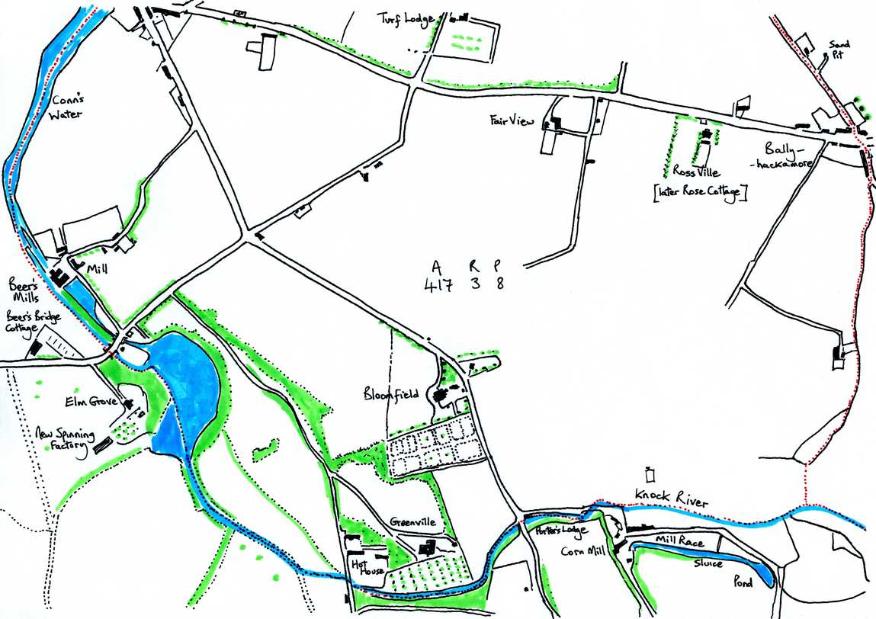
The map above, based on the first edition Ordnance Survey map from c.1835, shows much of the townland of Ballyhackamore (partially encircled here by the red dotted line). Trees and woodland have been coloured green and the rivers, ponds and dam coloured blue. The road along the top is the road to Newtownards and Comber.
Beersbridge Road, as now is, meets that main road, near the middle top (Note: going straight on leads to the house of Turf Lodge). Farther back, the cross roads on the Beersbridge Road is what would now be the Bloomfield Avenue and Bloomfield Road junction.
Greenville has a hot house and what may be an extensive planting of perhaps fruit trees; Bloomfield has a well-organised patchwork of possibly ornamental flowerbeds or fruit and vegetable plantings.
The large pond or mill-dam adjacent to Elm Grove and Greenville was the subject of an 1839 court case, detailed in the PDF below (entitled The 1851 Beersbridge Mill Disaster, pp. 8-15). Interestingly, that surely rules out the Conn O'Neill stone bridge being much earlier than mid-19th century.
Mr J Fitzpatrick was the collector of customs at Belfast. His subsequent move to Strangford doesn't seem to be a promotion! Page 2 of the Belfast News-Letter for Tuesday 9 February 1847 has this:
Robert Hunter, Esq., of the custom-house, Strangford, has been promoted to the collectorship of Coleraine, vacant by the death of Mr. Ogle. Mr Fitzpatrick, of the custom-house, Belfast, succeeds Mr. Hunter, at Strangford.
It's likely that 'Ross Ville' on the map is a mistake for 'Rose Ville'. It was 'Rose Ville' when advertised in the Northern Whig on 11 August 1842 (page 3) - see the first of the thumbnail pics below (please click on these to enlarge).
The advertisements were repeated through to November, but clearly with little success. Then, on page 3 of the Belfast Commercial Chronicle for Saturday 5 October 1844, it was announced that 'Rosevale' [sic] would be auctioned on 7 October at the Sale-Rooms of Mr. Hugh C. Clarke, No.5 Rosemary-street, Belfast at Twelve o'clock.
Did Robert Boyd buy it then - apparently in advance of signing the deal for Bloomfield?
History repeats itself, or so some think. Certainly this is another case! Robert Boyd bought Bloomfield House, once described as in great condition. He then thought it was in wretched condition and spent much money in fixing it up.
Now, with 'Rose Ville', described in 1842 as 'in excellent repair', Boyd advertised it as 'Rose Cottage' and 'To Be Let' in 1846, - 'all in perfect order; the house having been new roofed, papered, and painted' (see the second pic below).
Note that the farm element has been reduced to 'an extensive well enclosed garden, with sufficient ground, &c.'
And the rent is £50 per annum (Belfast Commercial Chronicle, 18 July 1846, page 3).
Five years later (see the third pic) the cottage has just a walled-in yard, some stabling 'and a good garden'.
Appropriately, the rent has now reduced to £25 per annum (Northern Whig, 7 June 1851, page 3).
Rose Cottage's tenant, probably from 1851 and certainly through to 1865 was James Kennedy Jackson, a solicitor, the Coroner for Co. Antrim and the Deputy Clerk of the Crown. See a little more about him in the PDF on the right.
Robert Boyd in the later 1840s
Robert Boyd and his family attended the charmingly elliptical First Presbyterian Church in Rosemary Street, a church with a long-standing liberal tradition - something which is reflected in many of Robert Boyd's dealings.
The architect Thomas Jackson, mentioned in that court case above and certainly associated with Robert Boyd in the later 1840s and 1850, designed the Music Hall in May Street in 1839 (RH pic) and then began work on St Malachy's Roman Catholic Church in Alfred Street close by.
RH pic: Thomas Jackson's Music Hall built in 1839 for the concerts and weekly rehearsals of the Belfast Anacreontic Society.
Pic from Belfast & Its Environs: or, Stranger's Guide, Henderson, Belfast 1855.
When St Malachy's Church was consecrated in December 1844, an
unholy row (a not untypical Belfast occurence to this day!) broke out
concerning the Mayor's attendance. It's good to see the names of Robert
Boyd and the Steens in the list of 315 Belfastians who signed an address
in support of the Mayor. More details in the PDF below.
LH pic: The fan vaulted ceiling in St Malachy's Church, Belfast. Photo by Kevin Lynch, 2009.
Courtesy of a Creative Commons Attribution-Share Alike 4.0 International license.
In April 1846, along with 13 others, Robert Boyd and James Steen were elected officers of the Belfast Chamber of Commerce 'for the present year'.
The following month, Robert Boyd's father, also Robert, died on 3 May 'at his residence, Marlacoo, County Armagh, ... aged 73 years'.
The Potato Famine may have been raging, but page two of the Belfast Commercial Chronicle for Saturday, 5 September 1846, carried a lengthy report entitled Belfast Botanic Gardens - Fruit and Flower Show, including this:
Mushrooms – The best dish, 1st prize to Robert Boyd Esq. Bloomfield; gardener, Samuel Johnston.
However, famine was indeed all too present. 1846 was a bad year with potato blight, smallpox, dysentery and then, in 1847, a serious outbreak of typhus.
The
same newspaper, for Wednesday 11 November 1846, carried a report on
page three of 'A Meeting of Gentlemen' held in the office of J & T
Sinclair, Tomb-street, on Monday 9 November,when three resolutions were
agreed:
'That this meeting thankfully accept the offer of
One Hundred and Fifty Pounds, voted by the Provision trade, out of
their funds, for the purpose of establishing a Soup Kitchen, in Dock
Ward.’
'That the Soup be disposed of, at a price under cost, the charge to be fixed by the Committee.’
'That the following gentlemen, with liberty to add to their number, be
appointed a Committee for carrying out the objects of this meeting, by
obtaining subscriptions, procuring premises, and establishing the Soup
Kitchen.'Then followed a list of 30 names, including that of Robert Boyd. Subscriptions were to be paid to any member of Committee. Anyone with suitable premises to let were invited to apply to John Campbell, the Secretary.
In similar vein, John Kane Esq., the Mayor of Belfast, responded positively to the following notice which appeared on page three of the Vindicator on Wednesday 23 December 1846:
WE, the undersigned, request you will call a MEETING of the Inhabitants of Belfast and its vicinity, on an early day, to consider the propriety of memorialing Government to suspend the use of Grain in Distilleries and Breweries, while the existing scarcity of food continues in this country.
Belfast, Dec. 19, 1846.
There followed a list of 81 names, amongst which were Robert Boyd and his business partner James Macnamara.
On page two in the Northern Whig for Thursday 14 January 1847, there was news of a public meeting attended by 'owners and masters of vessels of the port of Belfast'. 15 trustees were unanimously elected for the Merchants' Seamen's Fund to serve 'for the ensuing year'. Robert Boyd was named in the list, though not singled out as being one of the four new members.
The newspapers did seem to like publishing lengthy lists. The Belfast News-Letter for Tuesday 26 January 1847, published another one on page three entitled: Belfast / Relief Fund for Ireland / Subscriptions.
The subscriptions included Andrew Mulholland & Son £200, also Richardson, Brothers & Co.
Then followed people at £100, including James Steen & Co; John and Thomas Sinclair.
There were many at £50 including Sir Arthur Chichester Bart., and James Macnamara.
Charles Lanyon gave £40, and amongst many at £25 is our Robert Boyd.
There was a great occasion for Robert Boyd and James Macnamara on 17 September 1847 when their new ship, the Lina, was launched from Connell's shipyard. It was surely named after Robert Boyd's mother, Martha Lina Turkington who had died in 1843. One of his daughters was also named Martha Lina, born in 1836. The ship was described as a clipper (usually three-masted vessels, fully square-rigged on all masts).
As already mentioned above (referencing a Belfast Telegraph
article on 30 April 1942), the Lina's launch celebrations were unfortunately marred by a
tragic accident.
The full and gruesome details are given in the PDF on the right.
On track to the catastrophic Owen O'Cork Mill Disaster of 1851
The first part of the Belfast and County Down Railway’s vision for a rail network opened in August 1848 with the single-track line from Belfast’s Queen’s Quay to Holywood. Then, in May 1850, the single-track line was opened from Queen’s Quay, through the Bloomfield lands, to Newtownards via Knock, Dundonald and Comber.
Robert Boyd, having put up with the ‘great annoyance’ of
those railway labourers ‘cutting up the farm', would not live long
enough to see the Bloomfield railway station opened in 1879.
Interestingly, alongside the Marquess of Donegall, both Robert Boyd and his business partner, James Macnamara, J.P., had been members in 1845 of the provisional committee of BCDR's rival for the lucrative Belfast to Holywood route: the wonderfully named Atmospheric Railway Company. That company was eventually persuaded not to compete for the business, leaving the way open for BCDR.
RH pic: Advertisement from Henderson's Belfast and Ulster Directory, 1856.
Unbeknownst to him, Robert Boyd’s life was about to be derailed – and the prelude to that was a major new acquisition in the shape of the Owen O’Cork mill (aka Beer’s-bridge Mill or Bloomfield Mill) just down the lane or across the fields from Bloomfield House.
The singular use of ‘mill’ actually incorporated a steam-driven large flax tow spinning mill and a corn mill which used water from the Conn’s Water river and also steam. It was the corn mill which leads back at least to the 17th century mentions of Owen O'Cork.
The mill had had a long and chequered history, certainly from before 1670, including bankruptcies, fires, malicious rumours and, in 1840, an alleged assassination attempt on the then owner William Radcliff.
Fuller details of the mill’s history (including the alleged assassination attempt) are provided as the preface (pages 1-24) of the PDF farther below about the 1851 Mill Disaster.
Appendix 1 (page 86) of that same PDF provides some genealogical details of both the mill-owning Radcliff and Munce families.
Appendix 2 (page 91) is a newspaper report on the 1849 court case Donegall v. Templemore about ownership of two Belfast quays and with mentions of ‘the mill called Owen-o-Corke’.
William Radcliff died in 1847, though the Owen O’Cork mill’s lease seems to have been previously taken over by his nephew William Radcliff Munce and that lease was renewed in 1848.
Before reaching the 1851 trauma, we take one little step backwards for a description of the flax spinning mill:
Northern Whig – Tuesday 03 December 1844, page 3
(also in the Belfast Commercial Chronicle – Saturday 21 December 1844, page 3)
SPINNING MILL TO LET.
TO BE LET, FOR SUCH TERM AS MAY BE agreed on the large TOW SPINNING-MILL of OWEN O’ CORK, otherwise called BEERS’-BRIDGE [sic], situate within one mile of Belfast. The above Mill has been recently and substantially built, with Fire-Proof Arches, &c.; and is fitted up with the requisite Spinning and Preparing Machinery, which is driven by a Forty-Horse Steam-Engine, all fit for immediate work. None but Principals will be treated with.
For further particulars, apply to W. R. MUNCE, on the Premises; or to RICHARD P. TIGHE, Esq., 20 Middle Gardiner-Street, Dublin.
One of the outcomes of the Irish Famine in the latter half of the 1840s was the 1849 Encumbered Estates’ Court Act established by the British Parliament. It facilitated the sale of Irish estates and properties effectively bypassing one or more owners who held an ‘entail’ previously preventing the property being sold.
William Radcliff Munce had plans to realise his inheritance and move on (eventually emigrating to Australia in 1853).
And so the Owen O’Cork Mill was auctioned in Dublin on 3 May 1850 by order of the Commissioners for the sale of Encumbered Estates in Ireland.
Biddings began at £2,000 and ended at £5,500 in favour of Mr. Robert Boyd.
There was an interesting postscript in the report of this sale on page 4 of the Shipping and Mercantile Gazette for Monday 6 May 1850:
The commissioners have come to the resolution of allowing the purchasers of properties the option of paying for the present half of the purchase money, reserving the remainder until Sir J. Romilly’s bill shall have been disposed of, in order that they may receive the benefit of that measure in case it shall pass into law.
Sounds a bit like 0% finance for the first year!
The new Owen O’Cork mill owners were Robert Boyd, his brothers-in-law James Steen and William Steen, and Robert's business partner James Macnamara.
The date of the new ownership was eventually recorded on the mill’s entrance gate-posts – the relevant gate-post sadly now removed to make way for large lorries.
RH pic: Entrance to the Owen O'Cork mill.
Photograph courtesy and copyright of the East Belfast Historical Society from its compilation The Past in Pictures, grant-aided by the Heritage Lottery Fund.
Just two years later, in the 'Village Directory' section of The Belfast and Province of Ulster Directory for 1852, Robert Boyd seems to have relinquished what had been his dominant position in the mill heirarchy:
Beer’s Bridge
Owen-O’Cork Mill Company – Jas. Steen & Co.,
proprietors
Wm. Malloy, land steward And no wonder. Robert Boyd stood accused of murder.
After their successful purchase at the auction, the partners lost no time in developing the mill.
A large new mill building, designed (and its erection supervised) by the architect Thomas Jackson was successfully built in spring 1850.
Then a second smaller mill building was constructed, this time without an architect’s input.
On the morning of Friday 10 January 1851 at 8.10am, just as the last slates were being placed on the roof of the second new mill, it collapsed.
The final death toll was sixteen men, with six injured. They are all named on page 36 of the PDF farther below.
Belfast News-Letter - Monday 13 January 1851, page 2
... In an incredibly short time, the scene of the disaster was crowded by multitudes of people, from the adjacent neighbourhood, some in a state of distraction inquiring after their relatives, others to assist in the task of clearing away the ruins und extricating the victims of the calamity. As soon as the intelligence reached Belfast, hundreds of persons went out to the locality …
… During the laborious and melancholy task of extricating the bodies, the scene which presented itself to the spectators was absolutely harrowing. As each corpse, mangled and mutilated, was drawn to light, and recognised by the relatives, the most piercing shrieks of women and children rent the air. For hours, on Saturday, standing on the verge of the excavation, under a drizzling rain, females might be heard raving in a kind of delirium, uttering the incoherent phrases suggested by the agony of their hearts. It is not necessary to state, that the ruins themselves present a truly deplorable spectacle. With the exception of the small part of the structure which still remains standing, in a shattered state, it may be literally said, that not one brick or stone stands upon another, the whole of the interior fixtures, supports, etc., lying in a confused heap, amidst the cavities made by the workmen.
There followed a protracted inquiry, spread over many days. It was hot and heavy.
Those called to give evidence included architects Thomas Jackson and Charles Lanyon, and also John Godwin, professor of civil engineering at Queen’s College, Belfast and Engineer to both the Ulster Railway Company and the Belfast and Co. Down Railway.
Complete transcripts of the Belfast News-Letter reports are presented in the long-promised PDF below.
Again, they make fascinating reading (the detailed Disaster inquiry is from page 25 onwards).
What caused the collapse? Was it the proximity of the Conn’s Water? Poor foundations? Too many old bricks being reused? Too many incomplete old bricks (known as ‘bats’)? The quality of the Belfast mortar made of hydraulic lime? The contractor’s lack of experience? No clerk of works? Was Robert Boyd culpable or did the sole responsibility reside with John Magee, the contractor he employed?
Interesting that Robert Boyd’s business partner, James Macnamara, Esq., J.P., was present at least for part of the inquiry along with other magistrates. A conflict of interest?
Charles Lanyon, the county surveyor for Antrim who worked on roads and bridges – particularly the Antrim Coast Road – and designed a wide variety of major buildings in Belfast, most notably Queen’s College (later Queen’s University) and Crumlin Road Gaol, stated that he’d inspected the fallen mill building at some length:
I concur generally in the evidence of Mr. Godwin. I attribute the accident altogether to the giving way of the brickwork; and I concur with Mr. Godwin, in saying that the building was erected in bad weather, and that the materials were insufficient — being a mixture of old and new brick. If the materials had been good, I would have been satisfied with the thickness of the walls. (The contract and plan were here produced.) This comes in the form of specification and tender. It would depend on the person to whom it was confided, whether that would be sufficient. I think it would have been more prudent to have employed an architect, but I think the work could be done without him. I consider a man of common sense is bound to employ a competent architect or builder to execute the work. I do not think it was right to build upon the old standing brick work.
The PDF file on the right contains a preface detailing some of the history of the Owen O'Cork Mill - including surely a mention of Conn O'Neill's Bridge; then (from p.25) a transcript of the inquiry over many days. Appendix 1 (p.86) provides details of the Radcliff and Munce families (proprietors of the mill over the previous 30 years) and Appendix 2 (p.91) is an account of the 1849 court case Donegall v. Templemore which references the mill.
One jury member was for finding against Robert Boyd alone.
A majority (14 members) found that ‘Robert Boyd and John Magee [the contractor] are wilfully and feloniously guilty of the improper construction or erection of the said mill’.
The minority (7 members) submitted that ‘although we consider the falling of the said mill an accidental circumstance, we cannot avoid recording our opinion that sufficient care was not taken in its erection, although we do not consider that that neglect amounts to criminality.’
Robert Boyd’s solicitor was quick to enter a caveat against that majority finding:
NOTICE
In the matter of the inquiry as to the deaths occasioned by the falling
of the mill at Beers’ Bridge, COUNTY OF DOWN TO WIT.
Sir, — As solicitors for Robert Boyd, Esq., we hereby call your attention to the fact, that the finding the jury, contained in the inquisition executed this evening, so far as relates to our client, is illegal and absurd. Of this, a reperusal of the document must at once satisfy you, as we presume it cannot be contended that the ‘improper construction and erection of a mill’ is a criminal offence, or can be made so by prefixing the technical terms ‘wilfully and feloniously’.
And further, as you have announced your intention to issue a warrant on the said inquisition, we hereby caution you at your peril not to do so, as such a course would be manifestly illegal, and render you subject to a criminal information in the Court of Queen’s Bench at the instance of our client.
Dated this 8th day of February, 1851.
H. J. & T. GARRETT, Solicitors, Belfast.
To Bernard Ward, Esq., Coroner.
Above pic: Owen O'Cork Flax Spinning Mill, July 1864 (courtesy and copyright of the East Belfast Historical Society from its compilation The Past in Pictures, grant-aided by the Heritage Lottery Fund).
RH pic: The mill in October 2012 © David Byers
Note: In the 1864 drawing above, the road on the left hand side of the picture is presumably what survived until a few decades ago as Steen's Row - a street with two terraces of mill houses. It's disappointing that that street name with its historic local reference has now been lost to the more sedate Elmgrove Road!
The photographs below of both sides of Steen's Row date from 1982.
Photos by AE McAlpine - used with permission.
Bloomfield House revealed
What of Bloomfield House itself?
The history has been detailed under the relevant dates on these web-pages, but a brief summary seems appropriate here. The likely first mention of Bloomfield House in the newspapers was in July 1776, when James Patrick’s newly built house (c.1775) was being let for 8 years by his widow.
The recently-deceased James Patrick had been the owner of a brewery and malt-house in North-street, Belfast.
The new house was described as being well finished, with a ‘large Kitchen, Dairy, Pantries, Cellar, Room for Servants, Parlour 18 by 24 Feet, and four Bed-Chambers, Closets, &c.’
Eight years later, in autumn 1784, Bloomfield House and Farm was on the market again, its sale handled by the merchant and banker John Hamilton. The lease then was for three young lives or the remaining 22 years of the 31-year lease – underlining the house's date of 1775.
The resident from 1776 to 1784 had likely been Mrs Hutchinson, mother-in-law of William Rainey, the neighbour in Greenville.1784-1786 remains a mystery, though the house contents were auctioned in June 1786.
From 1786 to 1789, the resident may have been James McVickar, merchant and ship-owner. Alternatively, he may simply have been the agent for the new letting. In his ‘To be let’ advertisement, James McVickar noted that it was ‘a good Dwelling, together with sufficient Office-houses, a large Orchard in full bearing, and Kitchen Garden; the Farm is highly improved, together with good ditches. The situation is remarkably fine, only one mile from Belfast; this place is very fit for the immediate reception of a gentleman.’
Thomas Bunbury, waiting to inherit Simon Isaac’s Holywood House, moved into Bloomfield House in 1789. His inheritance finally came through in 1796 (one condition being that he added Isaac to his surname).
So, in July 1796, the remaining lease was up for sale. This time there was little said about the house itself. ‘The Beauty of the Situation of the House, the earliness of the Garden, and the richness of the Grounds make it worth the attention of any Gentleman now wanting a Country Residence. – A Servant attends to shew the House …’
The period 1796 to 1798 is another mystery period, before the announcement in January 1798 of an auction at which Bloomfield was ‘To be sold by auction’. Again, the selling point was ‘The Beauty of the Situation and goodness of the Land … so well known as to render any further description unnecessary’. As if an afterthought, however, ‘The House and Offices are in good repair and fit for the immediate use of a genteel and numerous family’, … which led to the occupancy of Arthur Crawford and his family (1798-1831).
So far, no advertisements have been sourced for Bloomfield House’s change of ownership in 1831 when John Agnew, often the Sovereign of Belfast, took up residence with his family. He subsequently advertised his ‘eligible residence near Belfast with land attached, from September 1840 for almost 6 months, but failed to find a buyer. Most interestingly though, the description read: ‘The House is quite new …’
Meaning? Renovated, redeveloped, remodelled or rebuilt? Bloomfield House and Farm was then held under two leases, one from 1831 – presumably relating to the original purchase. The other was from November 1838 – perhaps relating to a major rebuild?
Despite that possibility, Robert Boyd claimed in 1847 that ‘the dwelling house and offices were in a very dilapidated state’ and he had to spend ‘upwards of £1,200’. Same questions: renovated, redeveloped, remodelled or rebuilt?
Boyd's court case with the Belfast and County Down Railway Company referred to him 'improving' the land and the dwelling house. Perhaps a couple of years later he set about a further rebuilding, maybe with some advice from the architect Thomas Jackson - though that seems less likely after Jackson was dragged into the 1851 mill collapse and court case!
The ship illustrations from contemporary newspapers are an
homage to Robert Boyd's wide shipping interests - more anon!
The earliest editions of Ordnance Survey maps seem to attempt approximations of specific buildings, unlike the maps from later in the 19th century which tend to show very stylised buildings – squares, rectangles, etc.
Compare Bloomfield House (LH pic below) from the first edition 6-inch map, c.1834, with the next edition made for Griffith’s Valuation some 20 years later (RH pic below).
The later map shows a significant transformation of house and gardens, with a considerable block of out-houses built around three small courtyards behind the house. But is the later one John Agnew’s 'new house' of c.1838 or Robert Boyd’s improved dwelling of c.1847 – or maybe even a further redevelopment in the early 1850s?
I suspect the later version is predominantly John Agnew's 'new house' with Robert Boyd's 'improvements'.
And that was the building which stood right through to its demolition, most likely in late 1938. Or was it?
The orientation of the house on the later map is difficult to understand when compared to the third photograph below in relation to the gates and drive-way.
This first photograph was kindly forwarded by Brian Sheil in February 2013 and shows Bloomfield House on its last legs in 1938, not long before its demolition. At this time the house had two cannons, one on each side of the doorway on the top step. One is visible to the right of the car bonnet. They were advertised for sale in August 1938, presumably just prior to the house's demolition. Might these be the cannons that ended up gracing the steps of the Royal Ulster Yacht Club, Bangor? See below the house pics for a photograph of Brian astride one of those Bloomfield cannons.
Pic below © Brian Sheil
The second and third more flattering photographs of Bloomfield House were kindly sent from Australia by Ian Temby in November 2013. Their date is problematical, but they seem to correspond in many ways to similar 'portraits' by Robert French for the Lawrence Collection - so they could reasonably be from the late 1860s. Wishful thinking?
Pics below © Ian Temby
The PDF on the right contains an evaluation of the architectural style of this strange house, based on the photographs above.
Brian Sheil also very kindly sent two additional 1938 photographs from Bloomfield House. Please click on the pics in the gallery below: one is a lovely period holiday snapshot of Brian (then just eight years of age) with his mother on the steps of Bloomfield House; the other is of Brian astride one of Bloomfield House's cannons.
Pics courtesy and © Brian Sheil.
Arson Attacks and an Earthquake at Bloomfield and Beyond
In 1849, Bloomfield was just one of the farms that suffered an attack during an outbreak of 'incendiarism'.
Incendiarism – the firing of haystacks and outbuildings – occurred throughout Ireland at this time and was long established in England, where it peaked in the late 1840s and again during the 1860s. It was a frightening issue for isolated farmers.
Read about it in the PDF below with its many newspaper reports (including 'J. Boyd' instead of 'R. Boyd' at Bloomfield).
It's worth bearing in mind that reliance on newspaper reports alone can skew the perspective for some, if not many, issues. Newspapers, then as now, represented the views of their readership – the Boyds, Agnews and Crawfords of the north of Ireland.
What was the root cause of incendiarism? Intimidation, a cry for help, or a social protest?
The immediate backdrop of the famine years and the years of depression is not addressed in these local newspaper reports. Nor is there any mention of reduced wages or redundancies because of low returns on grain for farmers following Peel’s 1846 repeal of the Corn Laws and the increased levels of cheaper imported grain.
No discussion then of poverty, depressed agricultural labourers’ wages, redundancies or hunger.
Much easier to blame unemployed, troublesome beggars or even the workers on the new railway!
After the fires, surely we need an earthquake? This one, courtesy of the Belfast News-Letter, 12 November 1852, page 2:
More to follow in due course ...
Belfast News-Letter, 3 April 1869
Belfast News-Letter, 23 May 1874
